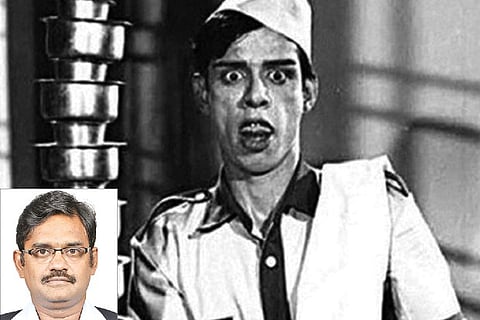

Chennai
COMEDY is an integral part of Tamil cinema; it is an aspect inherited from Tamil theatre. There had just been a world war and a huge depression that clouded the horizon. Times were bad and people needed to forget their worries. Who better than a comedian to accomplish that? There were giants like NS Krishnan, whose short films even were added to talkies to make them more ‘audience-friendly’. But, by the 60s people were getting tired of the prevalent comedy themes. It was getting too musty and repeated. Comedy in black and white talkies was verbal and preachy. The poet and the scriptwriter had the duty of making the audience laugh. Looking back, a lot of songs of Chandrababu’s are known for philosophy than laughter.
The vacuum of Chandrababu was what Nagesh filled. It was then that Nagesh burst on the scene. His timings and body language were making the brand of comedy novel and rib-tickling. He designed his flair that elicited laughter the moment he appeared on the screen. Soon, people clapped when his name appeared in the credits.
In Hollywood, Jerry Lewis had fashioned a pattern of humour that was based on self-deprecation. It soon caught on all over the world. The jester on stage was not the smarty pants but one who didn’t mind the quip being on him, as long as the audience chuckled. Nagesh seems to have shadowed that theme. It was unusual from the comedy of early cinema when comedians were often asked to preach in the name of jesting.
Krishna Rao Nageshwaran born in Dharapuram had followed his father into a railway job and worked as a clerk in an office on Waltax Road that opened into the Central Station. His lodge roommates, both of whom became well-known names in Tamil cinema were Srikanth and Vaali though they were known by their real names at that time.
Nagesh associated himself with theatre. Graduating from office plays and marriage hall entertainment, Nagesh entered the Tamil theatre. His first role was as a patient with a complaint to the doctor but he managed to steal the show. Soon, he started doing many roles across different drama troupes. The UAA of YG Parthasarathy got him a lot of attention. But Nagesh was aiming for the silver screen and it still eluded him. Early in his career, he got a chance to play the lead in an autobiographical venture called Server Sundaram — a typical story of thousands, who venture into the city in search of a career on the silver screen.
Nagesh had many issues loaded against him. With a face pockmarked by pox, people preferred him on stage far away from the audience rather than being shot by a camera at close angles. In 1962, stepping into the role of a ward boy in a hospital instead of an actor who was late for shooting in Nenjil Or Alayam, Nagesh got the break he was waiting for.
Self-effacing humour had scope for alternating scenes of pathos and humour and soon, Nagesh mastered the art. Audiences who laughed at his joke turned teary-eyed in a blink of an eye. Nagesh was an excellent dancer and easily reminded people of Charlie Chaplin. Directors insisted on giving atleast one song to him in the movie.
Nagesh even acted as a lead in some films where the hero is usually a disadvantaged character. Directors like K Balachander said that he wrote scripts with Nagesh in mind. He played with ease a cancer patient, a homeless boy living under the staircase of a middle-class colony, a hungry Sangam age poet, a bungling server in the hotel who aspires to be a film hero and more.
Much later in his career, it was Kamal Hassan who considered Nagesh a teacher disguised as a friend and gave some classic roles in his films — as a villain, as a corpse and so on.
Soon, Nagesh became the comedian leading heroes wanted to have in their films to ensure success. Both MGR and Shivaji knew the danger of acting with Nagesh. He stole the limelight from them as he does with MGR in Anbe Vaa and Shivaji in Thiruvilaiyadal. Dharumi, an improvised poet with questionable lyrical talent from the Sangam times, shot into the hall of fame after a millennium, when played by Nagesh in Thiruvilaiyadal.
Nagesh was respected by the intellectual authors as well. Jayakanthan, in his directorial venture, preferred Nagesh to take the lead role (instead of Shivaji as proposed by the producer) in Yarukkaga Azhudhan. The role of Vaithi, a pimp in Thillana Mohanambal, was a part that the author Kothamangalam Subbu wanted to play when it was produced as a movie. When Nagesh was chosen to play it and came out with flying colours, Subbu refused to go to the theatres to see the film.
Nagesh was level-headed and learned his lessons well. Comedians had always taken the applause and laughter to their head and turned to direction and production with disastrous effects. The man who held the top comedian post in Tamil cinema before Nagesh, Chandrababu had gone down that way. Nagesh never tried these experiments and concentrated on making people laugh.
Though many of his roles got stereotyped as it does over 800 films, he had some jewels that people remember him for. Nagesh got a National Award only towards the tail end. He must have thought having made people laugh over such a long time was an accolade enough.
— The writer is a historian and an author
Visit news.dtnext.in to explore our interactive epaper!
Download the DT Next app for more exciting features!
Click here for iOS
Click here for Android